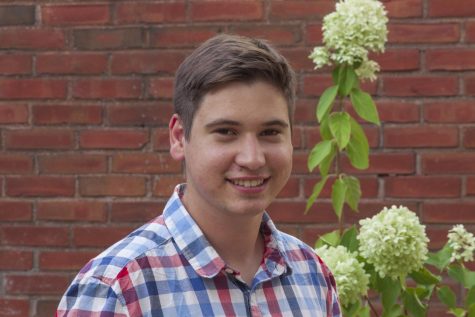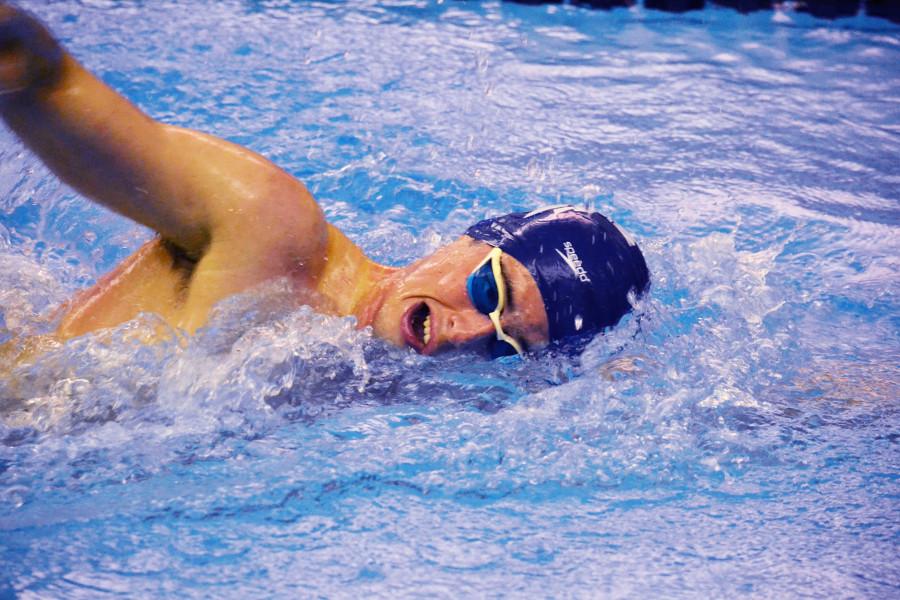CWRU swimmer no fish out of water in business world
Fourth-year CWRU distance free swimmer Felipe Gomez del Campo was named to “Forbes” magazine’s 30 Under 30 list in the energy category. He juggles his startup with coursework and varsity swimming.
For most Case Western Reserve University student athletes, juggling academics, athletics, clubs and a social life is hard enough. But when you add in running a company and conducting research, like fourth-year CWRU distance free swimmer Felipe Gomez del Campo, who was named to “Forbes” magazine’s 30 Under 30 energy list in early January, it can seem like 24 is nowhere near enough hours in a day.
Gomez del Campo credits men’s swimming Head Coach Doug Milliken for helping him navigate his crazy schedule. “You can manage every conflict if you plan ahead,” he said. “But it also takes a flexible coach.”
It also helps that Gomez del Campo’s office is in the Sears think[box], which is connected to the Veale Natatorium, where the swim team practices. He can spend all day in one building and not have to face the brutality that is Cleveland winter.
Another way he manages his time is by compartmentalizing. “Swimming is a very mental sport,” he said. “I think what I’ve tried to do a lot more is, when I walk in the pool, I don’t let myself think about anything [outside of the pool].” And when he is in his secluded office, one of only two on the fourth floor, he only works on the research that got him named to the prestigious list.
Gomez del Campo’s research is trying to use plasma and electric fields to enhance combustion in fuel injectors in jet engines. “I’m breaking apart the molecules, fuel and air, with plasma,” he explained. “It ends up giving you an additional degree of control over how you burn the fuel.” Research videos show that when the plasma is combined with fuel injection, the flame is much more controlled than compared to without it, increasing efficiency and decreasing fuel use.
The Gliding Arc Lean Direct Injection (GALDI) injector is the basis of his new company, FGC Plasma Solutions, which has been working with the NASA Glenn Research Center to integrate the new design into jet engines used on the next generation of airplanes. Because the GALDI is still in R&D, it’s better to implement it with the new planes, Gomez del Campo explained. So, CWRU students and alumni won’t be able to fly in a plane equipped with a fellow Spartan’s design just yet.
Gomez del Campo started his research as a science fair project in his garage in high school, so it’s fitting that the lab he does his research in now, a room on the first floor of Glennan, was an old lab for the Ford Motor Company. The small injector system is dwarfed by large engines, still sitting from projects terminated decades ago.
Recognition for his research is nothing new for Gomez del Campo. In May 2015, he met with President Barack Obama and members of the television show “Shark Tank” as part of a White House event recognizing young entrepreneurs. “I don’t think I’ve ever been that nervous,” he admitted.
As for the 30 Under 30 list honor, he takes it with a grain of salt because, as he explains, there aren’t many twenty-somethings in charge of big energy projects. This is best exemplified by when he found out about the news, he was training with the swimming team in Florida. “I didn’t even think about it that much,” he said, because he was focusing on training.
In April there will be a summit with 200 people from the United States, 200 people from Europe and 200 people from the Middle East and Africa of the 6,000 people recognized by “Forbes” in Israel. If he is selected, Gomez del Campo will be ecstatic.
As for the future, Gomez del Campo says he will continue to work hard. “I really need to focus now on the science,” he said. “This year has to be living up to [the hype].”
Perseverance will be key, and he says he will transfer a lesson learned from swimming, where after powering through over a thousand miles in a year, he only sometimes drops time. This can be equated to research, where months in the lab might yield no conclusive results.
Next year the aerospace engineering major will be off to graduate school, where he will continue developing his idea and his company, his swimming career, and begin working on his thesis. Hopefully he’ll even manage to get some sleep in too.

Eddie Kerekes is in his fourth year studying chemical engineering while also pursuing a minor in German. He serves as the executive editor. Previous roles...


